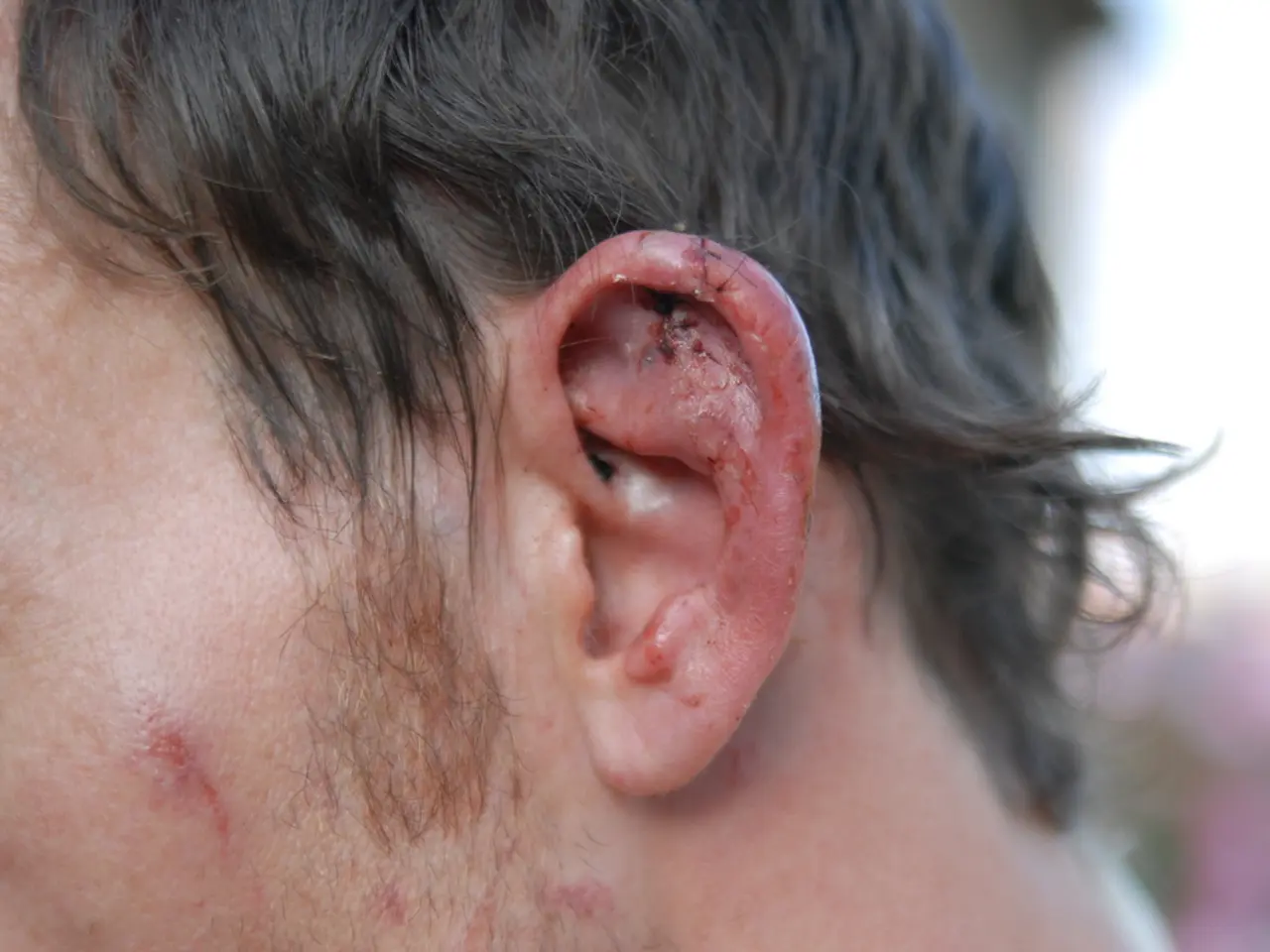Numbness in the arm: 9 potential reasons and situations when seeking medical advice is necessary
Arm numbness can be a concerning symptom, and it's essential to understand its potential causes and appropriate treatment options. This article provides an overview of the common causes and potential treatments for arm numbness.
One of the most serious causes of arm numbness is a heart attack or stroke. These conditions occur when blood flow to a particular area is restricted or completely blocked, leading to symptoms such as pain or discomfort in the arm, chest pain, shortness of breath, and nausea. In such cases, immediate medical attention is crucial to restore blood flow and prevent permanent damage.
Other common causes of arm numbness include circulation issues, peripheral neuropathy, thoracic outlet syndrome, cervical spinal stenosis, herniated disk, hemiplegic migraine, and dehydration. Each of these conditions requires a different approach to treatment.
Circulation issues, for example, can be treated by elevating the arm and managing underlying vascular problems. Peripheral neuropathy, caused by nerve damage from diabetes, infections, or toxins, requires managing the underlying cause and symptom relief. Thoracic outlet syndrome, cervical spinal stenosis, and herniated disk may benefit from physical therapy, medications, injections, or surgery.
Hemiplegic migraine, a rare migraine variant, causes numbness and weakness, and is managed with migraine prevention and acute treatments. Dehydration, while not a common cause of arm numbness, can lead to temporary numbness due to an electrolyte imbalance, treatable with rehydration.
In some cases, arm numbness may be caused by less common conditions such as anxiety-induced hyperventilation, carpal tunnel syndrome, and pinched nerves.
Initial treatment for arm numbness often involves at-home care, including rest, ice, elevation, and over-the-counter anti-inflammatory medications. Physical therapy is key for conditions such as pinched nerves, thoracic outlet syndrome, cervical spine conditions, and peripheral neuropathy, focusing on improving posture, nerve gliding exercises, joint mobilization, and strengthening weak muscles to relieve nerve compression.
Medications, such as NSAIDs for inflammation and corticosteroid injections for inflammation and pain relief, may also be prescribed. Lifestyle modifications, including avoiding repetitive movements, improving ergonomics, maintaining hydration, and managing stress, can help reduce symptoms.
Surgical interventions are considered when conservative treatments fail, including decompression surgery for thoracic outlet syndrome, disc removal for herniated disks, or carpal tunnel release surgery.
If numbness persists beyond a few weeks, or is accompanied by weakness, severe pain, or other concerning symptoms, medical evaluation is essential to identify the exact cause and tailor treatment appropriately.
In conclusion, arm numbness can be caused by a variety of conditions, ranging from minor circulation issues to serious conditions such as heart attacks and strokes. It's crucial to seek medical advice if experiencing sudden or unexplained arm numbness, especially for those with a high risk or history of cardiovascular disease. Early diagnosis and appropriate treatment can significantly improve outcomes.
[1] Mayo Clinic. (2021). Arm numbness. Retrieved from https://www.mayoclinic.org/symptoms/arm-numbness/basics/causes/sym-20050780 [2] American Physical Therapy Association. (2021). Thoracic outlet syndrome. Retrieved from https://www.moveforwardpt.com/SymptomsConditionsDetails.aspx?cid=1f67d9a7-32e8-43a9-9d20-82e3d841d607 [3] National Institute of Neurological Disorders and Stroke. (2021). Cervical spondylosis. Retrieved from https://www.ninds.nih.gov/Disorders/All-Disorders/Cervical-Spondylosis-Information-Page [4] American Heart Association. (2021). Heart attack symptoms. Retrieved from https://www.heart.org/en/health-topics/heart-attack/symptoms-of-a-heart-attack-in-women-and-men/symptoms-of-a-heart-attack-in-women-and-men [5] American Migraine Foundation. (2021). Hemiplegic migraine. Retrieved from https://americanmigrainefoundation.org/resource-library/hemiplegic-migraine/ [6] National Institute of Neurological Disorders and Stroke. (2021). Stroke. Retrieved from https://www.ninds.nih.gov/Disorders/All-Disorders/Stroke-Information-Page [7] National Institute of Neurological Disorders and Stroke. (2021). Dehydration. Retrieved from https://www.ninds.nih.gov/Disorders/All-Disorders/Dehydration-Information-Page
- Arm numbness can also be attributed to less common conditions like anxiety-induced hyperventilation, carpal tunnel syndrome, and pinched nerves.
- Physical therapy plays a significant role in treating conditions such as pinched nerves, thoracic outlet syndrome, cervical spine conditions, and peripheral neuropathy by focusing on nerve gliding exercises, joint mobilization, and strengthening weak muscles.
- Certain medications, such as NSAIDs for inflammation and corticosteroid injections for inflammation and pain relief, may be prescribed to alleviate symptoms associated with arm numbness.
- Lifestyle modifications, including avoiding repetitive movements, improving ergonomics, maintaining hydration, and managing stress, can help reduce the symptoms of arm numbness.
- Surgical interventions might be considered when conservative treatments fail, such as decompression surgery for thoracic outlet syndrome, disc removal for herniated disks, or carpal tunnel release surgery.
- If the numbness persists, particularly if accompanied by weakness, severe pain, or other concerning symptoms, professional medical evaluation is essential to accurately diagnose the cause and tailor appropriate treatment, especially for individuals with a high risk or history of cardiovascular disease.




